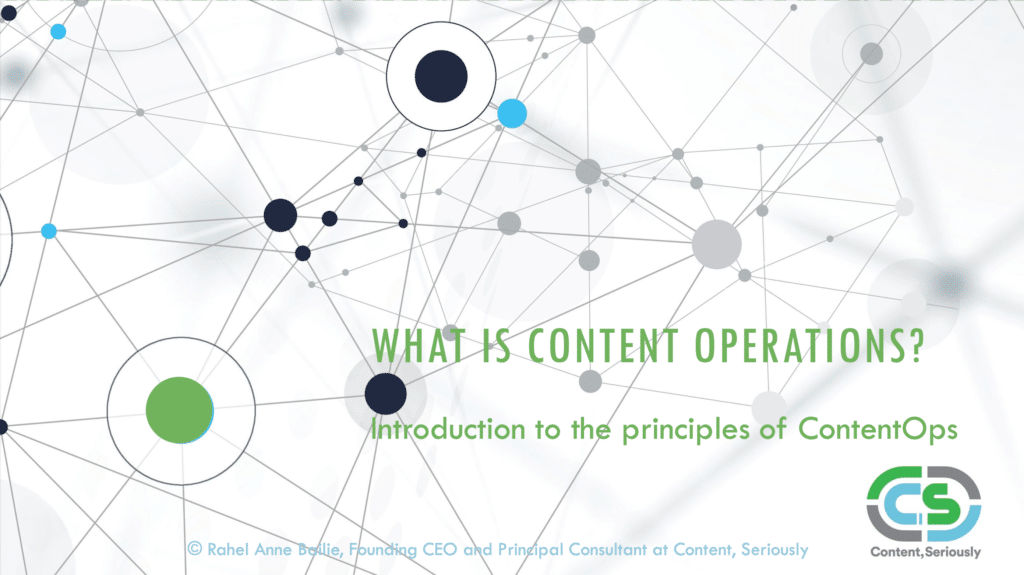What Is Content Operations? What’s old is new again, and the area of content operations falls squarely in the middle of that old adage. Deane Barker, respected consultant and author of Web Content Management, has found references to content operations in a blog post from over a decade ago. Similarly, I have found reference to content operations in articles and presentations that I created some 10-15 years ago. Instead of hearing crickets in response to the term, this time round, content operations seems to be picking up speed.
A couple of theories have bounced around about why content operations, ContentOps for short, is gaining traction. One of those theories is concept formation – that is, when people learn to sort specific experiences into general rules or classes. Because concepts such as DevOps and DesignOps have become familiar terms, it’s a short mental stretch to consider what ContentOps might mean. Another theory is that the need for operational models has grown along with the size of our content corpora. It’s when enough organizations feel the pain of trying to manage a large body of content that they start to look for ways to operationalize their processes.
For many of the practitioners among us, the last ten years has been focused on content strategy. But a content strategy is worthless if an organization says thank-you-very-much and pops the carefully crafted, elegant strategy into a drawer to gather dust. It’s worth clarifying some of the concepts and reframing them to make sense of content operations.
Content strategy vs content operations
Content strategy is the formation of a plan that codifies a repeatable system that governs the management of content throughout the entire content lifecycle. In other words, why are we creating a content strategy? To come up with a way to operationalise content processes! If there is no implementation phase, then the strategy is just that: an unimplemented plan. The content strategy needs to connect to content operations, whether that’s planning for more efficiency on the marketing or editorial side, or it’s designing a technical content ecosystem to increase delivery efficiencies. Sometimes, it’s both. In organizations that can squander time and effort – 13 people in 6 departments over 3 months in a recent benchmarking exercise – content operations is not a luxury; it’s critical to a competitive edge.
Published: 12 Jan 2022
File size: 1 MB
Author: Rahel Bailie
Precursor to content operations
It’s worth mentioning here that content operations has been practiced by technical communication communities for decades – they didn’t call it by that name. It was usually called “survival in the face of more content with less budget”. Even before proper systems for managing content existed, operational models were being developed by organizations with large content corpora. At one multinational company, we created a bank of “chapters” that were stored centrally, and drawn out to be mixed-and-matched according to the size and complexity of the product. Of course, version control was rudimentary, and editing was still done manually across the 80+ writers to create a single voice.
Early content operations
In the 1990s, I had my first aha moment while listening to a practitioner discuss how they managed training content for a suite of enterprise account software. They created a series of training modules, one per product: one for accounts receivable, one for accounts payable, and so on. They set up parallel structures for other language translations, such as French, German, and several other languages. When a client bought a series of products, the trainers structured a custom training package according to what they’d bought, in English, and then specified the output language, and the training material was delivered electronically to a local shop for printing. Pretty heady stuff for the late 1990s!
Now, we have our choice of content management systems into which we can paste publication-ready copy to be maintained. Or better yet, our publication-ready content can be sent via API into the Web CMS, for even more operational efficiency. The technology stack looks impressive. (Take a look at the Semantic Web Stack on Wikipedia for an example.) But a web CMS only the tip of the iceberg when it comes to how we actually manage content production.
ContentOps for technical content
In very large organizations, the technical communication groups may have implemented some form of ContentOps. It makes sense, as the function of technical communication often involves managing massive amounts of content with astounding amounts of complexity. They’ve taken on ContentOps out of sheer survival. In fact, there is a subdomain called DocOps that has a strong following in this area, of super-efficient processing of technical documentation.
ContentOps for marketing content
These efficiencies tend not to have migrated yet to the marketing side of the house, where a typical technology stack – and I use the word in a very tongue-in-cheek way – involves Google Docs or Microsoft Word, email for sign-offs, sticky notes on a computer monitor, and a spreadsheet to track it all. And we are so used to being system-poor and process-deficient that no one in our organizations are even recognizing the need for proper processes to be handled within a robust system to support content operations.
ContentOps for all
This is where opportunity comes in, to leverage the potential for content operations at a very fundamental level. Now that organizations recognise the need for an operational model for content, there’s also the potential to pool resources to find ways to work smarter instead of harder. Ventilating the silos between marcom and techcomm for their mutual benefit leverages the potential for efficiency and effectiveness for organizations as a whole. And when that connection happens, it’s a beautiful thing.

ABOUT THE AUTHOR
Rahel Anne Bailie, Content, Seriously
Rahel is a results-driven, seasoned consultant with extensive experience in digital transformation. She has a strong track record of delivering end-to-end content systems in the context of digital strategy projects, often in environments with complex content delivery requirements. A professional who delivers the hard truths and sometimes difficult prescriptions that help organisations leverage their content as a business asset.



 Information operations in a digital environment
Information operations in a digital environment